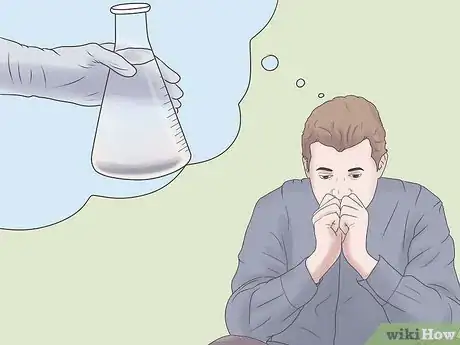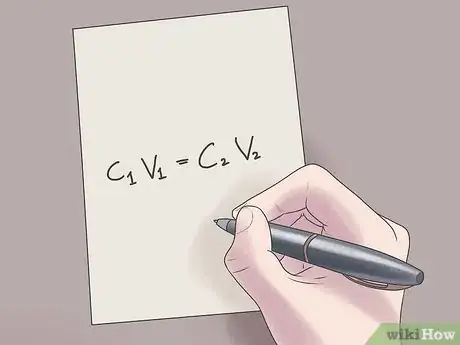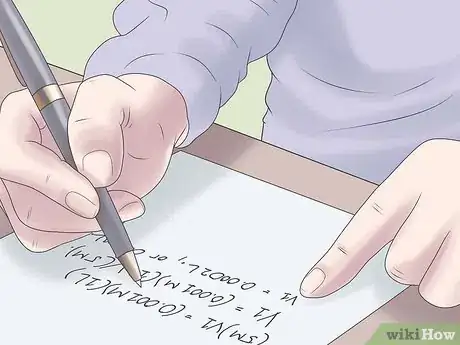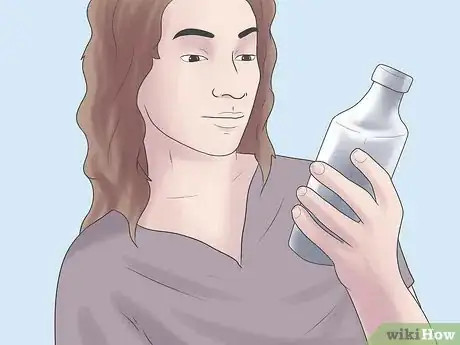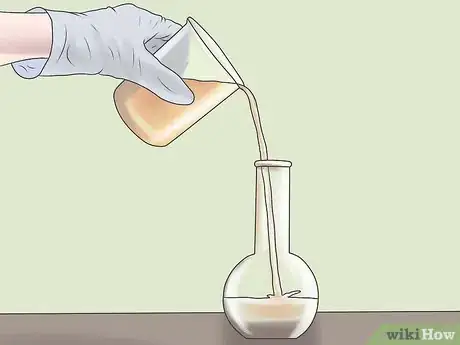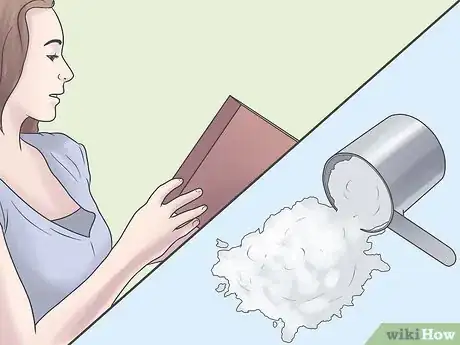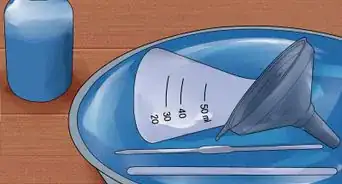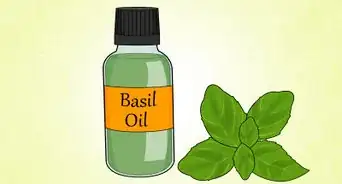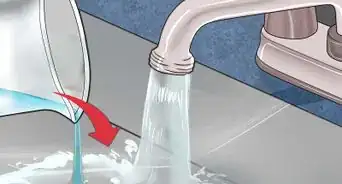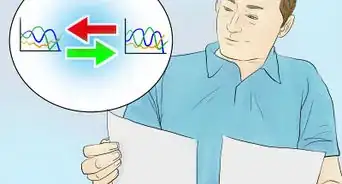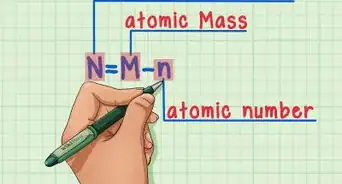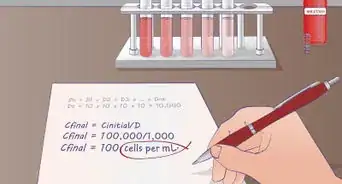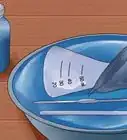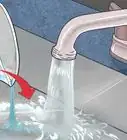This article was co-authored by Bess Ruff, MA. Bess Ruff is a Geography PhD student at Florida State University. She received her MA in Environmental Science and Management from the University of California, Santa Barbara in 2016. She has conducted survey work for marine spatial planning projects in the Caribbean and provided research support as a graduate fellow for the Sustainable Fisheries Group.
This article has been viewed 387,257 times.
Dilution is the process of making a concentrated solution less concentrated. There are a variety of reasons why one might want to perform a dilution. For example, biochemists dilute solutions from their concentrated form to create new solutions for use in their experiments. As a more casual type of dilution, bartenders often dilute hard liquor with a soft drink or juice to make a cocktail more palatable. For diluting solutions in lab experiments, the formal formula for calculating a dilution is C1V1 = C2V2, where C1 and C2 represent the concentrations of the initial and final solutions, respectively, and V1 and V2 represent their volumes.
Steps
Accurately Diluting Concentrates via Dilution Equation
-
1Determine what you do and don't know. Performing a dilution in chemistry usually means taking a small amount of a solution whose concentration you know, then adding a neutral liquid (like water) to make a new solution with a larger volume but a lower concentration. This is done very frequently in chemistry labs, as, for efficiency's sake, reagents are often stored at relatively high concentrations which are then diluted for use in experiments. Usually, in most real-world situations, you will know the concentration of your starting solution and both the concentration and volume you want in your second solution, but not the volume of the first solution you need to use to get there.[1]
- However, in other situations (especially in schoolwork problems), you may need to find some other part of the puzzle - for instance, you may be given an initial volume and concentration, then asked to find the final concentration if you dilute the solution to a given volume. In the case of any dilution, it's helpful to take stock of known and unknown variables before beginning.
- Let's tackle an example problem. Say that we're tasked with diluting a 5 M (molar) solution with water to make 1 liter (0.3 US gal) of a 1 mM (millimolar) solution. In this case, we know the concentration of the solution we're starting with and the target volume and concentration we want, but not how much of the initial solution we need to add water to get there.
- Reminder: In chemistry, M is a measure of concentration called Molarity, which indicates moles of a substance per liter.
-
2Plug your values into the formula C1V1 = C2V2. In this formula, C1 is the concentration of the starting solution, V1 is the volume of the starting solution, C2 is the concentration of the final solution, and V2 is the volume of the final solution. Plugging your known values into this equation will allow you to find the unknown value with minimum difficulty.[2]
- You may find it helpful to put a question mark in front of the variable that you are solving for.
- Let's continue our example. We would plug our known values in as follows:
- C1V1 = C2V2
- (5 M)V1 = (1 mM)(1 L). Our two concentrations have different units. Let's stop here and proceed to the next step.
Advertisement -
3Account for any differences in units. Because dilutions involve changes in concentration (which can sometimes be quite large), it's not uncommon for two variables in your equation to be in different units. Though this is easily overlooked, mismatching units in your equation can cause your answer to be orders of magnitude off. Before solving, convert all values with differing concentration and/or volume units.[3]
- In our example, we use different units for concentration M (molar) and mM (millimolar). Let's convert our second measurement to M:
- 1 mM × 1 M/1,000 mM (There are 1,000 mM per 1 M.)
- = 0.001 M
- In our example, we use different units for concentration M (molar) and mM (millimolar). Let's convert our second measurement to M:
-
4Solve to find the missing variable. When all your units match, solve your equation. This almost always can be done with simple algebra.[4]
- We left our example problem here: (5 M)V1 = (1 mM)(1 L). Let's solve for V1 with our new units.
- (5 M)V1 = (0.001 M)(1 L)
- V1 = (0.001 M)(1 L)/(5 M).
- V1 = 0.0002 L., or 0.2 mL.
- We left our example problem here: (5 M)V1 = (1 mM)(1 L). Let's solve for V1 with our new units.
-
5Understand how to use your answer practically. Let's say you have found your missing value, but you're unsure of how to apply this new information to a real-world dilution you need to perform. This is understandable - the language of math and science sometimes doesn't lend itself to the real world. When you know all four values in the equation C1V1 = C2V2, perform your dilution as follows:[5]
- Measure the volume V1 of the solution with concentration C1. Then, add enough diluting liquid (water, etc.) to make a total volume V2. This new solution will have your desired concentration (C2).
- In our example, for instance, we would first measure 0.2 milliliters (0.007 fl oz) of our 5 M solution. Next, we would add enough water to increase the volume of the solution to 1 L: 1 L - 0.0002 L = 0.9998 L, or 999.8 milliliters (33.8 fl oz). In other words, we would add 999.8 milliliters (33.8 fl oz) of water to our tiny sample of solution. Our new, diluted solution has a concentration of 1 mM, which is what we wanted in the first place.
Making Simple, Practical Dilutions
-
1Read any packaging for information. There are a wide variety of reasons why you might want to make a dilution at home, in the kitchen, or in another non-chemistry lab setting. For instance, the simple act of making orange juice from concentrate is a dilution. In many cases, products that need to be diluted include information about the dilution that needs to be made somewhere on the packaging. They may even have precise directions to follow. Here are some things to look for when searching for information:[6]
- The volume of the product to use
- The volume of the diluting liquid to use
- The type of diluting liquid to be used (usually water)
- Special mixing instructions
- You probably won't see information about the precise concentrations of the liquids being used. This information is superfluous to the average consumer.
-
2Add the substance acting as the dilute to the concentrated solution. For simple household dilutions, such as the ones you might make in the kitchen, you only really need to know the volume of concentrate you're using and the approximate final concentration you'd like before beginning. Dilute the concentrate with an appropriate amount of diluting liquid, which is determined relative to the initial volume of concentrate being used.[7] See below:
- For example, if we want to dilute 1 cup of concentrated orange juice to 1/4 its initial concentration, we would add 3 cups of water to the concentrate. Our final mixture would have 1 cup of concentrate in 4 cups of total liquid - 1/4 its initial concentration.[8]
- Here's a more complex example: If we wanted to dilute 2/3 cup of concentrate to 1/4 its initial concentration, we would add 2 cups of water, because 2/3 cup is 1/4th of 2&2/3 cups total liquid.
- Be sure to add your substances to a vessel that's big enough to accommodate the final volume you want - a large bowl or similar container.
-
3Ignore the volume of powders in most cases. Adding powders (like certain drink mixes) to liquids usually doesn't need to be thought of as a "dilution." The volume change created by the addition of a small amount of powder to a liquid is usually small enough that it can be effectively ignored. In other words, when adding small amounts of powder to a liquid, just add the powder to the final volume of liquid you want and mix.
Community Q&A
-
QuestionHow can I prepare 5% of hydrochloric acid solution from concentrate HCl?
 Community AnswerMeasure out 5 ml. of HCl acid, transfer it to a 100 ml. volumetric flask, and fill the flask to the mark with deionized water.
Community AnswerMeasure out 5 ml. of HCl acid, transfer it to a 100 ml. volumetric flask, and fill the flask to the mark with deionized water. -
QuestionWhy should I dilute cleaning chemicals?
 Community AnswerIf they are concentrated, the fumes can be very harmful if they are breathed in, as they can damage the 'hairs' in the trachea. Furthermore, if they touch the skin, they can cause severe to mild irritation. Apart from this, they can also be harmful to the surface that you are trying to clean, especially if it is wood, or other such sensitive materials. All this is because cleaning products are usually strong alkalis.
Community AnswerIf they are concentrated, the fumes can be very harmful if they are breathed in, as they can damage the 'hairs' in the trachea. Furthermore, if they touch the skin, they can cause severe to mild irritation. Apart from this, they can also be harmful to the surface that you are trying to clean, especially if it is wood, or other such sensitive materials. All this is because cleaning products are usually strong alkalis. -
QuestionHow do I dilute a 0.9 percent solution of 500 ml to a .45 percent solution?
 Community AnswerProvided that your solvent (a major component) is nearly pure, then you need another 500 ml. Hence you will have 0.45 percent solution since you haven't changed the solute (a minor component). This is because you increased the total solution to 1L.
Community AnswerProvided that your solvent (a major component) is nearly pure, then you need another 500 ml. Hence you will have 0.45 percent solution since you haven't changed the solute (a minor component). This is because you increased the total solution to 1L.
Warnings
- Follow any safety guidelines provided by the manufacturing company or that your company requires. This is especially important if you need to dilute an acid solution.[9]⧼thumbs_response⧽
- Working with an acid solution may require more detailed steps and safety guidelines than diluting non-acid solutions.[10]⧼thumbs_response⧽
References
- ↑ https://www.training.nih.gov/assets/Lab_Math_II_Transcript_-_508.pdf
- ↑ https://chem.libretexts.org/Courses/Heartland_Community_College/CHEM_120%3A_Fundamentals_of_Chemistry/07%3A_Solutions/7.19%3A__Concentrations%3A_Dilution
- ↑ https://www.ncbi.nlm.nih.gov/books/NBK560924/
- ↑ https://chem.libretexts.org/Courses/Heartland_Community_College/CHEM_120%3A_Fundamentals_of_Chemistry/07%3A_Solutions/7.19%3A__Concentrations%3A_Dilution
- ↑ https://chem.libretexts.org/Courses/Heartland_Community_College/CHEM_120%3A_Fundamentals_of_Chemistry/07%3A_Solutions/7.19%3A__Concentrations%3A_Dilution
- ↑ https://www.training.nih.gov/assets/Lab_Math_II_Transcript_-_508.pdf
- ↑ https://chem.libretexts.org/Bookshelves/Introductory_Chemistry/Map%3A_Introductory_Chemistry_(Tro)/13%3A_Solutions/13.07%3A_Solution_Dilution
- ↑ https://www.youtube.com/watch?v=aZHPJ1sgOq4
- ↑ https://sciencing.com/how-to-dilute-acid-13710252.html
About This Article
To dilute solutions, such as simple household solutions, make sure you know the volume of concentrate you’re using and the approximate final concentration you’d like to wind up with. For example, if you want to dilute 1 cup of concentrated orange juice to ¼ its initial concentration, add 3 cups of water for a total of 4 cups liquid. To learn how to accurately dilute concentrates with dilution equations, keep reading!
